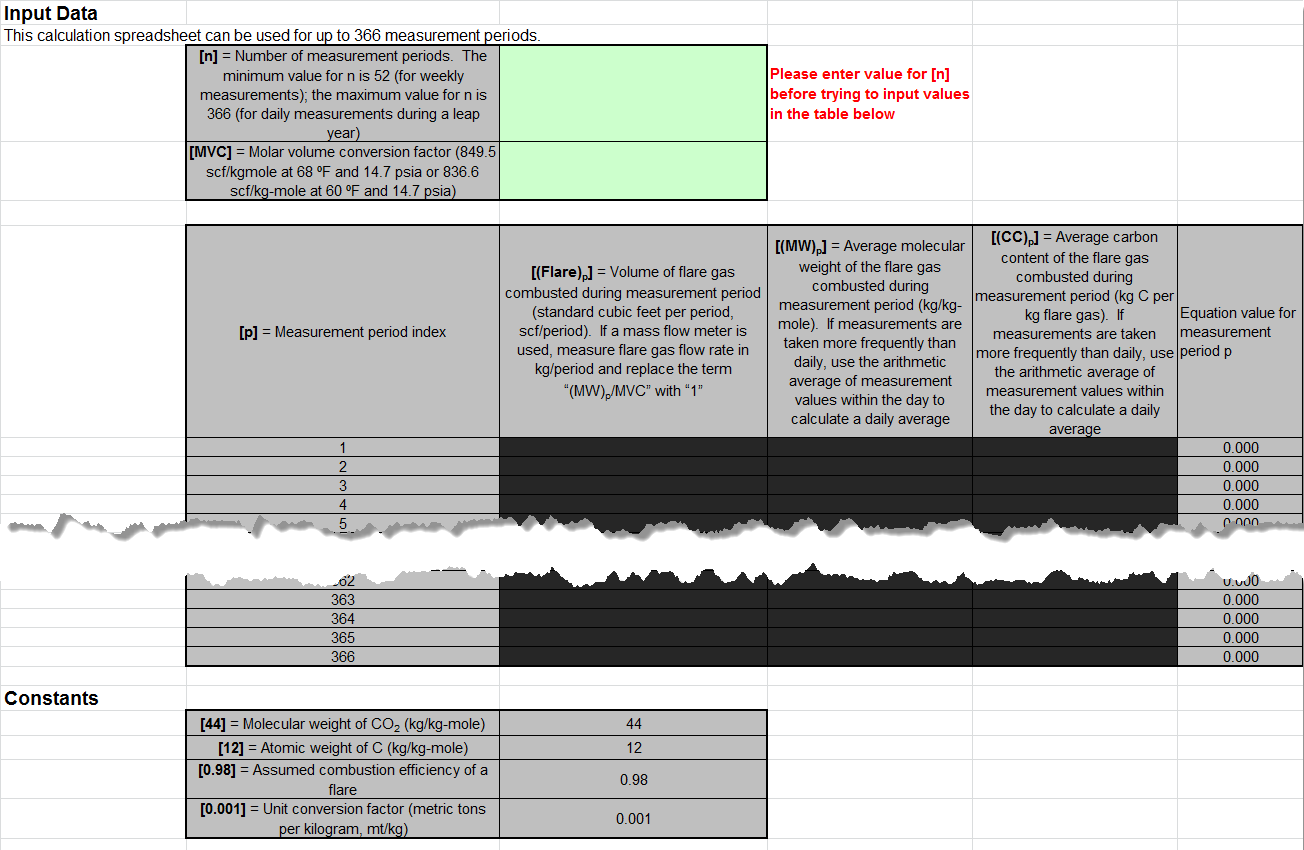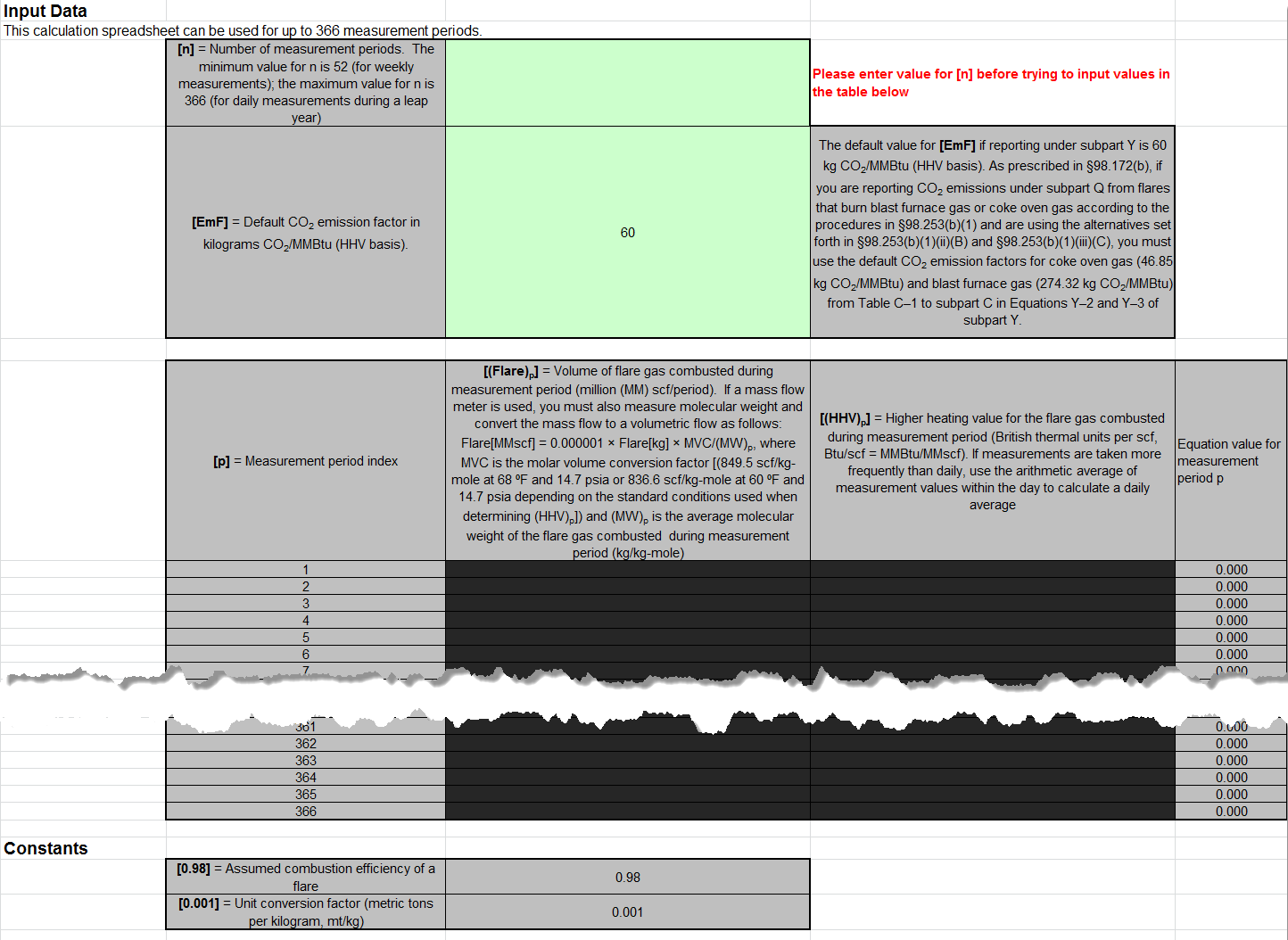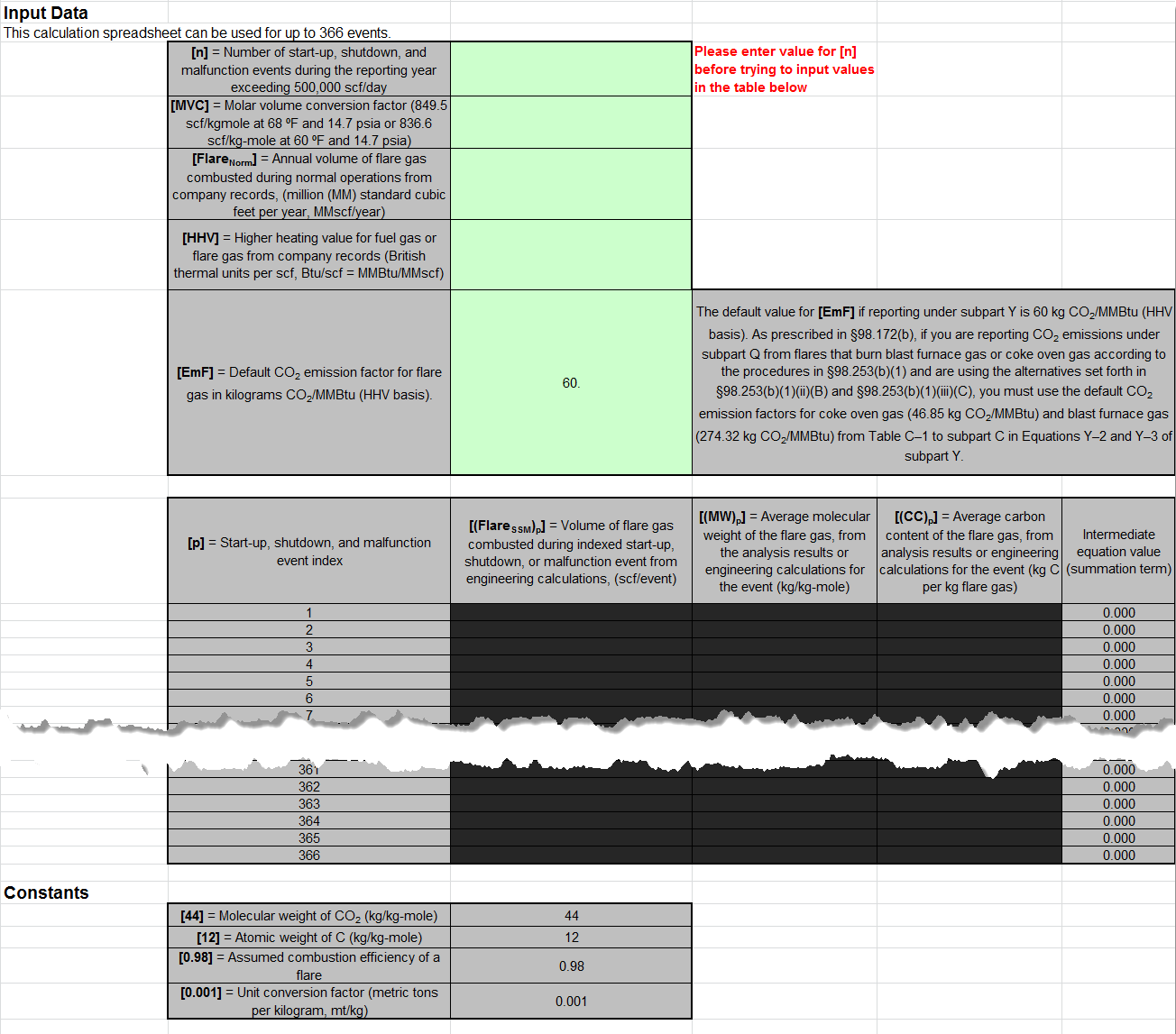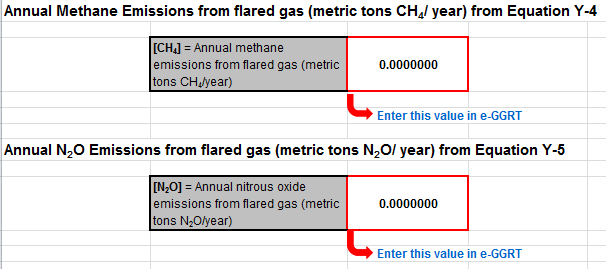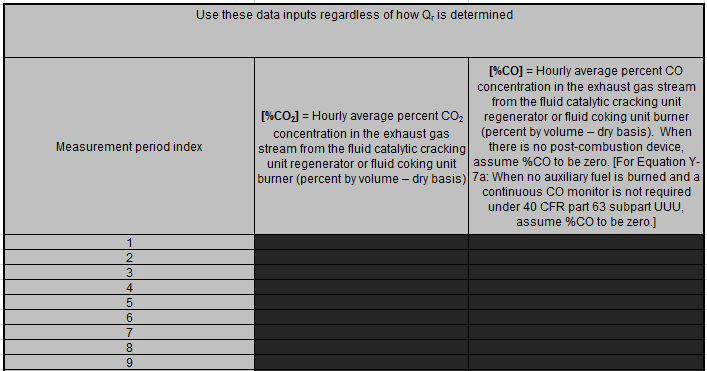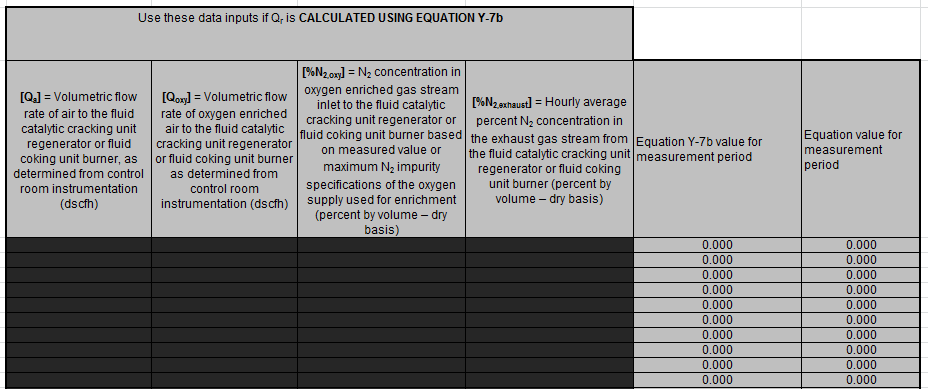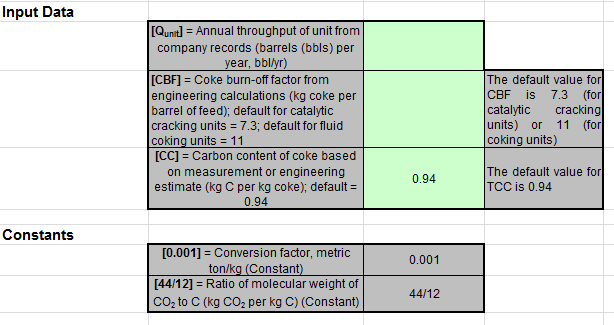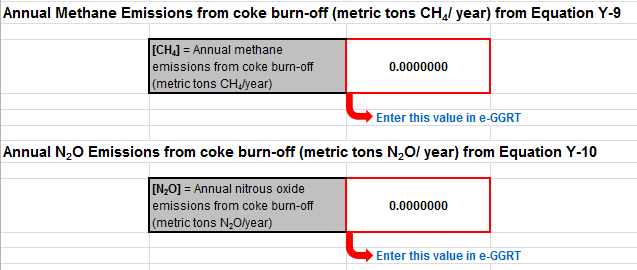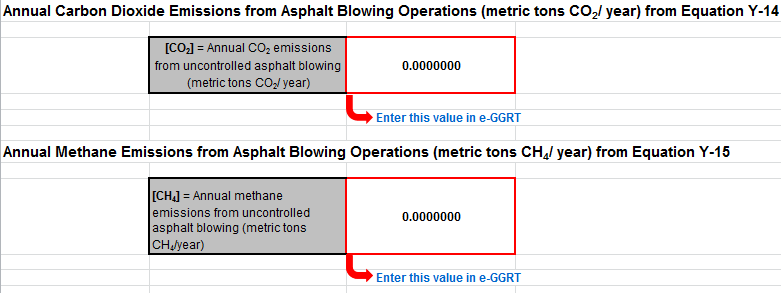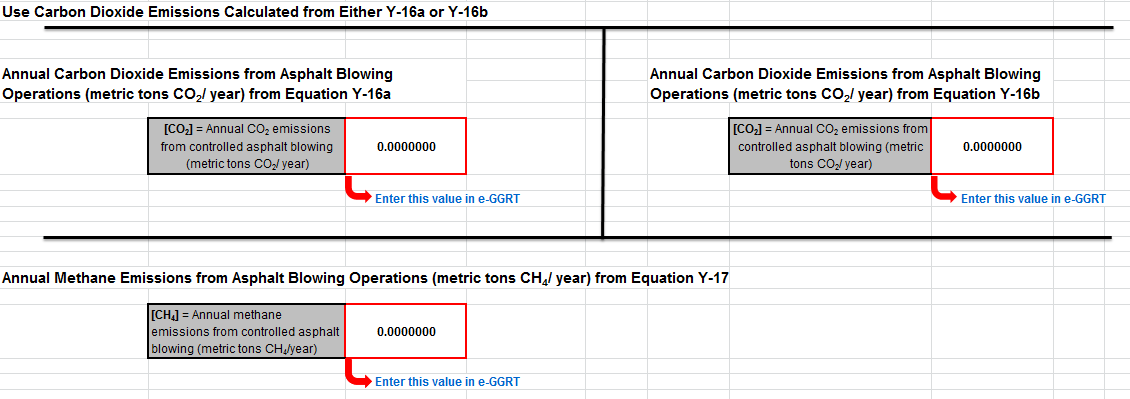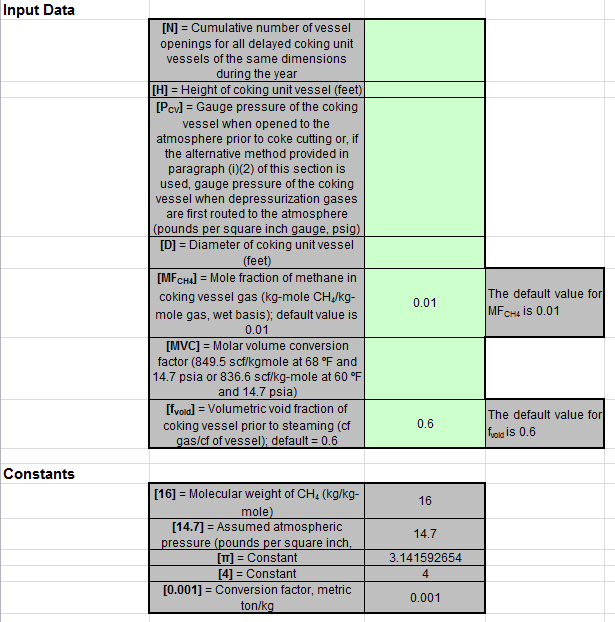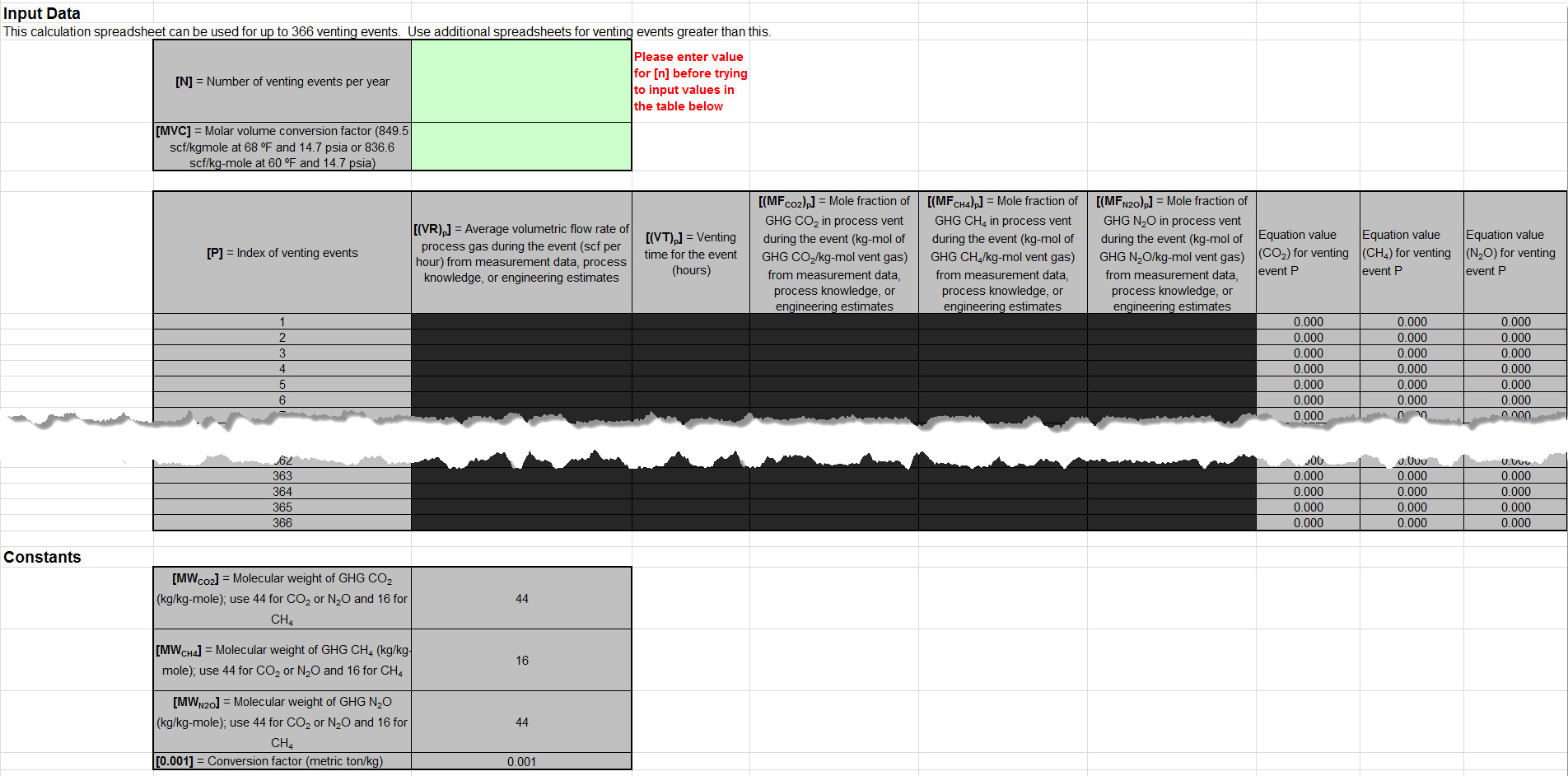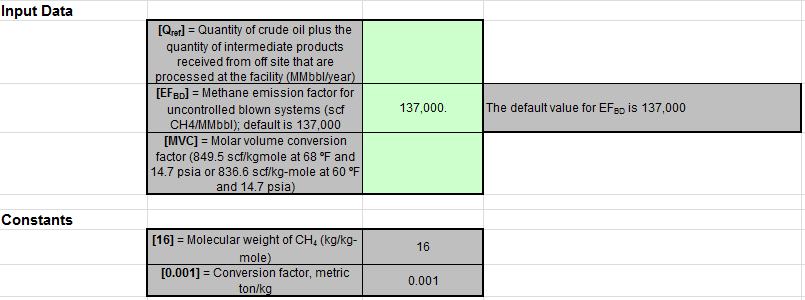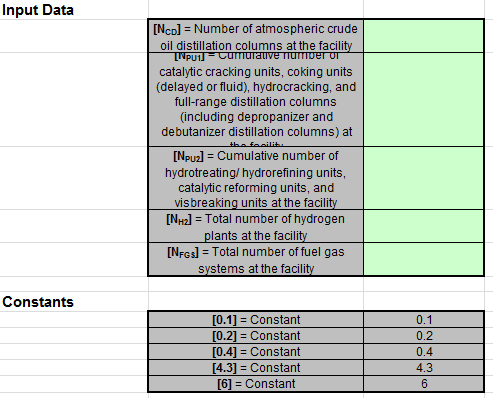| Anchor | ||||
|---|---|---|---|---|
|
| Excerpt Include | ||||||
|---|---|---|---|---|---|---|
|
...
Overview
This help page provides guidance for working with the supplemental Subpart Y calculation spreadsheets. The guidance provides step-by-step instructions for the following tasks:
...
The guidance provided in this section applies to each of the calculation spreadsheets for Subpart Y. Additional guidance is provided for each individual calculation spreadsheet in the sections below.
| Include Page | ||||
|---|---|---|---|---|
|
| Include Page | ||||
|---|---|---|---|---|
|
Multiple Units
For emissions sources under Subpart Y that require emission data to be reported for each unit, use separate calculation spreadsheets for each unit. Do not aggregate data for multiple units when calculating emissions from these sources using these calculation spreadsheets.
...
Next, enter the requested information in the green input cells in the first Input Data table. Based on your entries in the first Input Data table, a number of green input cells will be activated in the second Input data table. Enter the requested information in the green input cells in the second Input Data table.
The calculation spreadsheet will calculate the annual CO2 emissions for a fuel type combusted in a flare. The calculated value will be displayed in the red-bordered cell at the bottom of the spreadsheet. This value should be entered in e-GGRT and the Equation Y-4, Y-5 Calculation Spreadsheet for this flare. If different fuel types are separately monitored, add together the CO2 emissions calculated for each fuel type for a given flare and use the resulting sum for entry in e-GGRT and the Equation Y-4, Y-5 Calculation Spreadsheet for this flare.
| h3.anchor |
|---|
Using the Equation Y-1b Calculation Spreadsheet |
...
Next, enter the requested information in the green input cells in the first Input Data table. Based on your entries in the first Input Data table, a number of green input cells will be activated in the second Input data table. Enter the requested information in the green input cells in the second Input Data table. Space is provided for up to 20 carbon-containing compounds in the fuel stream.
| Wiki Markup |
|---|
| Composition Setup |
Wiki Markup
| Toggle Cloak |
|---|
|
|
Click image to expand
| Cloak | ||||||
|---|---|---|---|---|---|---|
| Wiki Markup | ||||||
|
| =none|cloak.toggle.zone=true}
| Panel |
|---|
| Wiki Markup |
|---|
{cloak} |
| ||
The calculation spreadsheet will calculate the annual CO2 emissions for a fuel stream combusted in a flare. The calculated value will be displayed in the red-bordered cell at the bottom of the spreadsheet. This value should be entered in e-GGRT and the Equation Y-4, Y-5 Calculation Spreadsheet for this flare. If different fuel types are separately monitored, add together the CO2 emissions calculated for each fuel type for a given flare and use the resulting sum for entry in e-GGRT and the Equation Y-4, Y-5 Calculation Spreadsheet for this flare.
| h3.anchor |
|---|
Using the Equation Y-2 Calculation Spreadsheet |
...
| Note |
|---|
If reporting under subpart Q per §98.172(b), you must report CO2 emissions from flares that burn blast furnace gas or coke oven gas according to the procedures in §98.253(b)(1) of subpart Y (Petroleum Refineries). When using the alternatives set forth in §98.253(b)(1)(ii)(B) and §98.253(b)(1)(iii)(C), you must use the default CO2 emission factors for coke oven gas (46.85 kg CO2/MMBtu) and blast furnace gas (274.32 kg CO2/MMBtu) from Table C-1 to subpart C in Equations Y-2 and Y-3 of subpart Y. |
The calculation spreadsheet will calculate the annual CO2 emissions for a fuel type combusted in a flare. The calculated value will be displayed in the red-bordered cell at the bottom of the spreadsheet. This value should be entered in e-GGRT and the Equation Y-4, Y-5 Calculation Spreadsheet for this flare. If different fuel types are separately monitored, add together the CO2 emissions calculated for each fuel type for a given flare and use the resulting sum for entry in e-GGRT and the Equation Y-4, Y-5 Calculation Spreadsheet for this flare.
| h3.anchor |
|---|
Using the Equation Y-3 Calculation Spreadsheet |
...
| Note |
|---|
If reporting under subpart Q per §98.172(b), you must report CO2 emissions from flares that burn blast furnace gas or coke oven gas according to the procedures in §98.253(b)(1) of subpart Y (Petroleum Refineries). When using the alternatives set forth in §98.253(b)(1)(ii)(B) and §98.253(b)(1)(iii)(C), you must use the default CO2 emission factors for coke oven gas (46.85 kg CO2/MMBtu) and blast furnace gas (274.32 kg CO2/MMBtu) from Table C-1 to subpart C in Equations Y-2 and Y-3 of subpart Y. |
The calculation spreadsheet will calculate the annual CO2 emissions for a fuel type combusted in a flare. The calculated value will be displayed in the red-bordered cell at the bottom of the spreadsheet. This value should be entered in e-GGRT and the Equation Y-4, Y-5 Calculation Spreadsheet for this flare. If CO2 emissions are estimated for different fuel types, add together the CO2 emissions calculated for each fuel type for a given flare and use the resulting sum for entry in e-GGRT and the Equation Y-4, Y-5 Calculation Spreadsheet for this flare.
| h3.anchor |
|---|
Using the Equation Y-4, Y-5 Calculation Spreadsheet |
...
Next, enter the requested information in the green input cells in the Input Data table.
The calculation spreadsheet will calculate the annual CH4 and N2O emissions from this flare. The calculated values will be displayed in the red-bordered cells at the bottom of the spreadsheet. These values should be entered in e-GGRT for this flare.
| h3.anchor |
|---|
Using the Equation Y-6, Y-7a, Y-7b Calculation Spreadsheet |
...
Before transferring the data to e-GGRT and the Equation Y-9, Y-10 Calculation Spreadsheet, enter the requested information in the green input cells in the first Input Data table.
Based on your entries in the first Input Data table, a number of green input cells will be activated in the subsequent Input data tables. Enter the requested information in the green input cells in the second Input Data table shown below regardless of how Qr is determined.
If you continuously monitor the volumetric flow rate of exhaust gas prior to the combustion of other fossil fuels, enter the requested information in the green input cells in the third Input Data table shown below.
If you do not continuously monitor the volumetric flow rate of exhaust gas prior to the combustion of other fossil fuels and calculated Qr using Equation Y-7a (based on percent concentrations of O2, CO2, and CO in gas stream inlet and/or exhaust gas stream), enter the requested information in the green input cells in the forth Input Data table shown below.
If you do not continuously monitor the volumetric flow rate of exhaust gas prior to the combustion of other fossil fuels and calculated Qr using Equation Y-7b (based on percent concentration of N2 in gas stream inlet and exhaust gas stream), enter the requested information in the green input cells in the fifth Input Data table shown below.
The calculation spreadsheet will calculate the annual CO2 emissions from each catalytic cracking unit and fluid coking unit. The calculated value will be displayed in the red-bordered cell at the bottom of the spreadsheet. This value should be entered in e-GGRT and the Equation Y-9, Y-10 Calculation Spreadsheet for this unit.
...
Next, enter the requested information in the green input cells in the first Input Data table.
The calculation spreadsheet will calculate the annual CO2 emissions from each catalytic cracking unit and fluid coking unit. The calculated value will be displayed in the red-bordered cell at the bottom of the spreadsheet. This value should be entered in e-GGRT and the Equation Y-9, Y-10 Calculation Spreadsheet for this unit.
| h3.anchor |
|---|
Using the Equation Y-9, Y-10 Calculation Spreadsheet |
...
Next, enter the requested information in the green input cells in the Input Data table.
The calculation spreadsheet will calculate the annual CH4 and N2O emissions from this unit. The calculated values will be displayed in the red-bordered cells at the bottom of the spreadsheet. These values should be entered in e-GGRT for this unit.
| h3.anchor |
|---|
Using the Equation Y-11 Calculation Spreadsheet |
...
Next, enter the requested information in the green input cells in the first Input Data table. Based on your entries in the first Input Data table, a number of green input cells will be activated in the second Input data table. Enter the requested information in the green input cells in the second Input Data table.
The calculation spreadsheet will calculate the annual CO2 emissions from a catalytic reforming unit. The calculated value will be displayed in the red-bordered cell at the bottom of the spreadsheet. This value should be entered in e-GGRT and the Equation Y-9, Y-10 Calculation Spreadsheet for this unit.
| h3.anchor |
|---|
Using the Equation Y-12 Calculation Spreadsheet |
...
Next, enter the requested information in the green input cells in the Input Data table.
The calculation spreadsheet will calculate the annual CO2 emissions from sour gas sent off site for sulfur recovery or annual CO2 process emissions from each on-site sulfur recovery plant. The calculated value will be displayed in the red-bordered cell at the bottom of the spreadsheet. This value should be entered in e-GGRT.
| h3.anchor |
|---|
Using the Equation Y-13 Calculation Spreadsheet |
...
Next, enter the requested information in the green input cells in the Input Data table.
The calculation spreadsheet will calculate the annual CO2 emissions from a coke calcining unit. The calculated value will be displayed in the red-bordered cell at the bottom of the spreadsheet. This value should be entered in e-GGRT and the Equation Y-9, Y-10 Calculation Spreadsheet for this unit.
| h3.anchor |
|---|
Using the Equation Y-14, Y-15 Calculation Spreadsheet |
...
Next, enter the requested information in the green input cells in the Input Data table.
The calculation spreadsheet will calculate the annual CO2 and CH4 emissions from asphalt blowing operations. The calculated values will be displayed in red-bordered cells at the bottom of the spreadsheet. These values should be entered in e-GGRT.
| h3.anchor |
|---|
Using the Equation Y-16a, Y-16b, Y-17 Calculation Spreadsheet |
...
Next, enter the requested information in the green input cells in the first Input Data table.
The calculation spreadsheet will calculate the annual CO2 and CH4 emissions from asphalt blowing operations. The calculated values will be displayed in red-bordered cells at the bottom of the spreadsheet. If you used an emission factor for CO2 from uncontrolled asphalt blowing from facility-specific test data enter the result from Equation Y-16b into e-GGRT, otherwise enter the result from Equation Y-16a into e-GGRT. The result for CH4 should also be entered in e-GGRT.
| h3.anchor |
|---|
Using the Equation Y-18 Calculation Spreadsheet |
...
Next, enter the requested information in the green input cells in the Input Data table.
The calculation spreadsheet will calculate the annual CH4 emissions from a set of similar delayed coking vessels. The calculated value will be displayed in the red-bordered cell at the bottom of the spreadsheet. If you elect to use the process vent method for the depressurization cycle, calculate CH4 emissions during depressurization using the Equation Y-19 Calculation Spreadsheet and add that value to the CH4 emissions calculated using the Equation Y-18 Calculation Spreadsheet for vessel openings. If you have multiple sets of delayed coking vessels, add together the CH4 emissions from all delayed coking vessels and enter the sum total into e-GGRT for delayed coking units.
| h3.anchor |
|---|
Using the Equation Y-19 Calculation Spreadsheet |
...
Next, enter the requested information in the green input cells in the first Input Data table. Based on your entries in the first Input Data table, a number of green input cells will be activated in the second Input data table. Enter the requested information in the green input cells in the second Input Data table.unmigrated-inline-wiki-markup
{
| Toggle Cloak |
|---|
|
|
Click image to expand
| Cloak | |||||||||
|---|---|---|---|---|---|---|---|---|---|
| Wiki Markup | |||||||||
|
| =none|cloak.toggle.zone=true}
| |||||||
| Panel |
|---|
| Cloak |
|---|
| Wiki Markup |
The calculation spreadsheet will calculate the annual CO2, CH4, and N2O emissions from for a process vent. The calculated values will be displayed in the red-bordered cells at the bottom of the spreadsheet. These values should be entered in e-GGRT for this process vent (or for this process unit for units electing to use the process vent method).
| h3.anchor |
|---|
Using the Equation Y-20 Calculation Spreadsheet |
...
Next, enter the requested information in the green input cells in the Input Data table.
The calculation spreadsheet will calculate the annual CH4 emissions from blowdown systems. The calculated value will be displayed in the red-bordered cell at the bottom of the spreadsheet. This value should be entered in e-GGRT for this unit.
| h3.anchor |
|---|
Using the Equation Y-21 Calculation Spreadsheet |
...
Next, enter the requested information in the green input cells in the Input Data table.
The calculation spreadsheet will calculate the annual CH4 emissions from equipment leaks. The calculated value will be displayed in the red-bordered cell at the bottom of the spreadsheet. This value should be entered in e-GGRT for this unit.
| h3.anchor |
|---|
Using the Equation Y-22 Calculation Spreadsheet |
...
Next, enter the requested information in the green input cells in the Input Data table.
The calculation spreadsheet will calculate the annual CH4 emissions from storage tanks other than those processing unstabilized crude oil. The calculated value will be displayed in the red-bordered cell at the bottom of the spreadsheet. This value should be entered in e-GGRT for this unit.
| h3.anchor |
|---|
Using the Equation Y-23 Calculation Spreadsheet |
...
Next, enter the requested information in the green input cells in the Input Data table.
The calculation spreadsheet will calculate the annual CH4 emissions from storage tanks that process unstabilized crude oil. The calculated value will be displayed in the red-bordered cell at the bottom of the spreadsheet. This value should be entered in e-GGRT for this unit.



